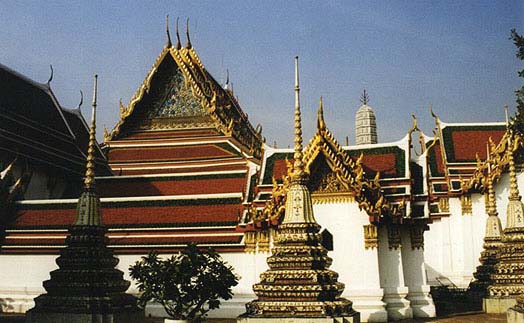Andy and I walked through one courtyard only to find another, just as big and just as impressive. Archways guided us to a square fringed all the way around with gold statues of the Buddha. Sunlight hit the statues and bounced back. When we walked back to the outer grounds, we discovered that more tourists had arrived, and the serenity ended abruptly.
Further into Wat Po, we found the Hall of the Reclining Buddha. At 15 meters high and 46 meters long, this daunting gold statue is the largest reclining Buddha in Thailand. The reclining pose is a popular position for statues of the Buddha. This style shows him lying on his side, propped up on his elbow, with his cheek cradled in his palm. The pose reminded me of a child sprawled out on the floor watching TV.
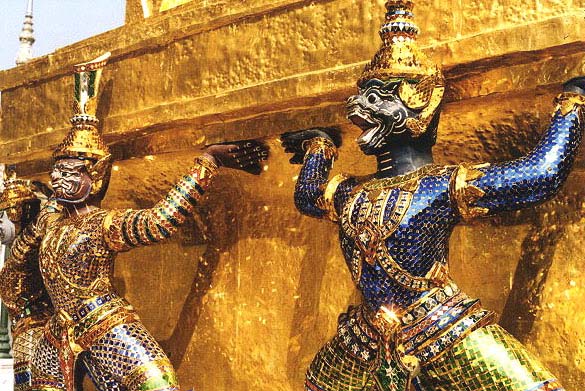 |
| Statue guardians at the Grand Palace |
Next door to Wat Po is the Grand Palace. Stone chedis stand guard at the entrance and jewel capped spires rise above grand doorways. Green tiled rooftops sweep downward. On the corners, golden tassels curve up and over like a rooster's tail. We started our tour at the Palace's Wat Phra Kaew or "Temple of the Emerald Buddha." Inside, women knelt and prayed in front of the famous Emerald Buddha. The "skin" of the statue is polished bright green, and a fresh cloth is draped over his torso. He is seated high on a platform with one hand gently raised. The statue's serene expression doesn't properly reflect its dramatic history. Apparently, the sacred image was discovered in 1434 when a lighting bolt struck a chedi in northern Thailand. While sifting through the ruins, an abbot came across the Emerald Buddha. This miraculous find captured royal attention, and over the centuries the statue was conveyed from Lampang to Chiang Mai to Vientiane to Bangkok as competing kings tried to claim it for themselves.
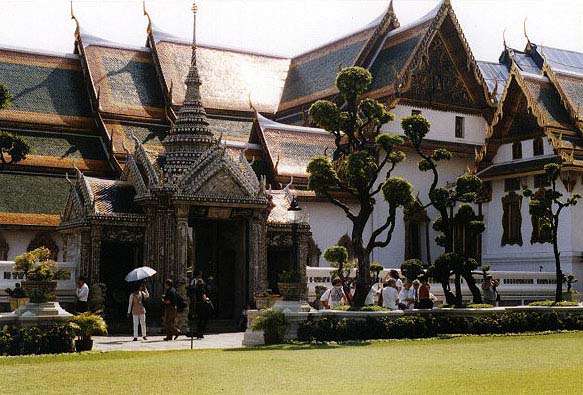 |
| Royal residence and gardens, the Grand Palace |
We ventured back out to the grounds where a swarm of tourists surrounded a palace guard. Like England's Beefeaters, the Thai Royal Guards stand at rigid attention, ignoring all distractions. People literally lined up to get their picture taken with him. They'd imitate him or pretend to lean on him. Andy wondered aloud whether guard duty was a reward or a punishment.
The sun got hotter as it crept toward midday, and shade became the prime objective. A postcard shop across from the Palace served Haagen Daz ice cream and Coke under a ceiling fan. Suddenly I wasn't complaining about the western influences anymore. We rested for about half an hour, staring at the curves of the palace rooftops and the occasional passing monk.
On our way to the next wat, we stumbled into a monastery school that was definitely not on the tourist map. Saffron cloth hung from clotheslines. Dogs curled up next to baskets of food. Young monks walked by. Chickens strutted through the courtyard as cats yawned and stretched. As much as I enjoyed being away from all the other tourists, I couldn't help but feel we were intruders in this gentle setting. No one said anything, but some of the monks watched us curiously. As we walked out, a monk, maybe in his early twenties, tossed us a smile and a hearty hello. We followed the narrow sidewalks back to the main streets and hailed a tuk-tuk.
Thai tuk-tuks are very similar to India's auto-rickshaws. They are, basically, glorified rider lawn movers with a roof and a back seat. Air rushes in; the motor buzzes, and you just sit back and watch the streets go by. They are called "tuk-tuks" because of the noise they make: "tuk tuk tuk tuk tuk." Tuk-tuks cost less than taxis, and they are much more fun.
The tuk-tuk pulled over at Wat Suthat. We took off our shoes, as is the custom before entering any wat, and climbed up the stairs. Inside monks led a group of women in prayer. The entire assembly chanted in unison, raising and dropping their voices in an ancient rhythm, to an age old prayer. All the woman sat facing an enormous statue of the Buddha with their feet tucked behind them in the mermaid position. In many parts of Asia, the feet are considered the dirtiest part of the body, so pointing them toward the Buddha would be an extreme insult. I stood outside the doorway for awhile, leaning against the stone railing. I could feel the air ripple with their voices, and I thought to myself, this is what I came here for.
After a few minutes, I walked down the stairs to get a closer look at a much smaller statue of the Buddha seated in front of the wat. This statue was about the size of a twelve year old boy. Like the 20 foot statue inside, its "skin" was a layer of gold, but unlike the one inside, it was covered with inch-long tags of gold leaf. I stepped back as worshipers came to lay lotus blossoms and incense sticks in front of the statue. When a breeze stirred the gold leaf, the whole statue seemed to shimmer.
Andy pulled out our guidebook, drew his finger along the city map and pointed us toward the markets of Chinatown and Indiatown. Like the bazaars of Jerusalem, these narrow passageways are covered with sheets of cloth and choked with shopkeepers, merchandise, and enough customers to give your average fire chief a coronary. The crowd flows through the corridors like a river torrent: starting, stopping, turning, weaving. My shoulders pressed against the people beside me. The air, thick with spice and sweat, is a visible haze. We followed the crowd past T-shirt stalls, beggars and underwear stands. I love the energy of these places, the drama, the deals. Mothers balance their children on their hips. Little boys in khaki uniforms poke at girls in blue and white school clothes. A young woman in flip flops lets down her long hair, so black that it has a blue sheen to it. An older woman in a powder blue suit rummages through a heap of children's toys.
The market was saturated with "Banana in Pajamas" paraphernalia: shirts, backpacks, purses all sporting a banana cartoon character. Fruit stalls, offering plants I had never seen before, stood alongside piles of plastic sandals. Alarm clocks were a popular item, and the merchants left the alarms on as a sort of advertisement. Every once in a while, above all the bargaining and hawking you could hear a half dozen alarm clocks blaring out like machine guns. Occasionally a motorcycle carrying rolled-up rugs parted the sea of people, and the crowd would come to a halt. I pressed my palms over my pockets and clasped my bag against my side. It is, after all, a pickpocket's heaven. In such narrow streets (if you could call them that), you have to travel at the speed of traffic. You move with it, curve with it, stop when it stops.
After we'd had our fill of the vibrant channels of Chinatown, we escaped back to the main road. Dodging taxis, trucks and tuk-tuks, we wandered the streets looking for a recognizable landmark. After some time and much staring at the map, we ended up at a red and gold wat. Every door was locked, and there were no other tourists in sight. In short, we were lost. Of course being lost in a foreign city is always an adventure, and we did our best to stay disoriented for a while.
Finally we wound up back at the hotel. We dropped our bags and sat down. The New Merry V Guest House, our modest hotel, has an open air cafe by the check-in desk. People from all over the world gathered at the tables. A German flipped his cigarette into an ashtray as an Australian rolled her long hair into a bun. The staff appeared to be made up entirely of young women with knee-length skirts, flip flops and pony tails who were always quick to toss a friendly sawatdee kha ("hello," pronounced sa-wa-dee-cah) our way. For some reason we hadn't been hungry since we arrived, and the cafe's bread rolls were just what we needed. We ordered two buns and bottled water, the same meal we'd ordered for breakfast. The young woman tilted her head and stared at us. Clearly she thought our exclusive bun diet was odd.
I wondered what the locals think of westerners in general. I would imagine the majority of visitors are either sweaty backpackers or horny men in town for the infamous night life, desperate for a martini and a shag. Then there are the businessmen, but most of them don't stay down here.
After our late lunch we walked across the street toward the river. On the corner of an alley and Soi Chana Songklam, a stout-armed woman flipped square noodles in a pan. At the Bangkok equivalent of a New York hot dog stand, she tended to a half dozen dishes from egg rolls to fried prawn. Down the alley, we found the docks. After laying down 6 baht each, we waited on the wooden planks for the ferry. The Chao Phraya River Ferry works just like a city bus. Commuters get on at their local stops and off next to their offices. At that time though, they were mostly headed home. Monks in saffron robes stood next to school boys. Women in business suits and men in work clothes waited together on the dock. We had to hold on to the railing as the platform rose and fell with the waves.
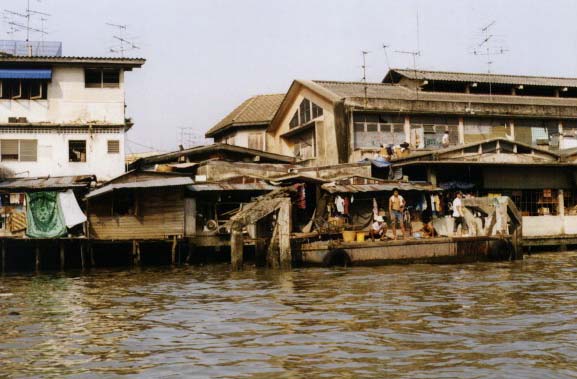 |
| View from the Chao Phraya River |
The ferry docked only for a few seconds, and everyone piled on to it - stepping from the wavering platform to the wavering deck. We sat down in the plastic bucket seats and watched the riverbanks of Bangkok. Children shampooed their hair and dumped buckets of water over their naked bodies. Workers in torn white shirts loaded cargo onto barges. Longboats sputtered past stilted scrap wood shacks. Far upstream, dozens of skyscrapers rode the riverbanks. The ferry created a wide wake, and the ensuing waves pounded against the docks.
We stepped off at the dock next to the Oriental Hotel. Thailand's answer to the Waldorf, it's home away from home for the rich and famous. In my faded blue jeans and dusty hiking boots, I was painfully out of place. The ceilings arched thirty feet above us. Overpriced stores boasted diamond jewelry and sweater vests. Even the velvet armchairs seemed to stiffen up and say, "You ought not to be here."
We ended up in the Author's Lounge where apparently Graham Greene used to hang out. On a raised platform, a flutist and a guitarist droned out awful renditions of "Yesterday" and "Don't Cry for Me Argentina." Two Asian women, dressed in long silk skirts and high heels, drank their tea with extended pinkies. They sat across from us in two Edwardian chairs, enjoying the hotel's high tea, which includes an assortment of cakes, pastries, sandwiches and scones.
Andy and I ordered a couple of scones and tea. I tilted my head all the way back to see the white billowing cloth draped from the high ceiling. The whole room was very.... white. A picture of Lady Diana, just recently killed in a car accident, rested on a table in a silver frame. The Earl Gray tea wasn't great, and the scone was pretty small for a buck fifty, but once I sat back, it was relaxing to watch the Polo clad tourists walk in and out.
One of the Asian women across from us stood up and sauntered toward the bathroom. While she was gone, the other one pulled out a camera, quickly snapped a picture of their meal, and tucked the camera back in her purse. It made me feel better to know that she too was impressed by the opulent setting. We weren't the only stowaways in this extravagant little world.
After the tea and scones, we went back out to the dock. We crossed a bridge of sandbags and wooden planks and made our way on to the ferry. As the sun sank lower, the wats along the riverbank faded into silhouettes.
We were both exhausted by the time we reached the hotel, but I really wanted to see a bout of Thai boxing. Muay Thai is one of the most popular sports in Thailand. This rib-cracking, leg-breaking form of kickboxing traces its origins back to the 15th and 16th centuries, when boxing was a mandatory part of military training. Today it's the national pastime, the ultimate contest where farm boys can become overnight heroes.
I dragged Andy out of bed and back onto the streets. A few shopkeepers catered to nighttime customers. Men gathered under awnings to smoke and talk. Dimly lit restaurants welcomed us with open doors and oscillating fans.
When we reached the main road, we decided it was time to find a tuk-tuk. The first couple of drivers couldn't understand what we were talking about since we didn't know how to say "boxing" in Thai (why we didn't just say "Muay Thai" I have no idea). After demonstrating a little shadow boxing and attempting to pronounce the name of the stadium, we found a guy who could decipher our request.
After a short ride, the tuk-tuk dropped us off at the mouth of Ratchadamnoen Stadium. We wove through a throng of boxing fans, drivers, and street vendors and finally ended up at the ticket window.
It was immediately apparent that the ticket sellers didn't want to come in contact with the fans. The "window" is a metal sheet with about six pencil-thin holes, for you to press your ear up to, and one fist-sized hole for you to speak through -- that is if you bend down and cock your head sideways. Andy's basic Thai is excellent, but he didn't know the words he needed for the situation, and after some confusion, we bought a pair of tickets for 210 baht each. At first, we were put off by the price. That's almost six US dollars a person. But soon enough we discovered it was well worth the price.
From the ticket booth we walked up stairs to the cheap seats, the "bleachers." The dark concrete staircase led to a third level and opened up on a vibrant circular stadium. Men stood on the terraced cement, waving their arms and shouting out numbers. A metal fence, like the kind you'd find at a ballpark, stood between the ring and the third level seats. I'm not sure if it's to protect the patrons from falling on to the ring, or to protect the ring from rowdy patrons. On the floor, two levels below us, were the ringside seats. At 810 baht per seat, you'd better hope your fighter wins. A small percussion set also stood on the main floor, drumming up a rapid heartbeat rhythm. In the center of the stadium, below the scoreboard, under the spotlights, was the ring.
 |
| Sketch of Muay Thai boxers |
Two men, dressed in silk boxing shorts and padded gloves, sized each other up. They danced around the ring, looking for the right move, the unguarded weakness, the winning slam. The man in red shorts struck first with a fierce kick to his opponent's ribs. This assault was countered by an uppercut, then suddenly both men went on the attack, kicking and punching at each other like street fighters in an arcade game. The crowd erupted in a chorus of "aaahs." The drums and bells kept the furious pace, until a gong marked the end of the round.
The fighters went to their corners, still sparing with the air. The gongs were turned upside down, chairs were placed on top of them, and the fighters sat on the chairs. Between rounds, the action shifted from the ring to the audience. Like the frenzied pits of the New York Stock Exchange, men shouted out numbers, placed bets and spoke in fast paced hand signals. Teenage boys in flip flops wove through the crowd balancing trays of slushy red drinks. Fans passed bits of paper, marked their fight cards and yelled across the stadium. The man in front of us wore a bright orange shirt and a scar shaped like a curled Victorian mustache. It was too sculpted to have been an accident. Maybe he'd pissed somebody off. I spotted only one other woman on the third level. Her plump arms popped out of her rolled up blue sleeves, and she yelled out her wagers louder than three men. I felt like we were standing in the eye of a hurricane as the betting, strategizing and exchanging swirled around us.
When the next round began, the action shifted back to the ring. All eyes turned to the stage, as the musicians set the pace, and the fighters emerged from their corners. Their bodies were perfectly cut. Sweat rolled down their rocky abs and taut thighs. As they cornered and danced, their silk shorts caught a sheen from the lights. One fighter threw a punch; the other kicked. They wrapped around each other and wrestled against the ropes. The fighter in blue kicked unmercifully at his opponent's ribs and groin. Finally, they came apart, danced for a second, then the fighter in red kicked the other smack in the face. Just like the kick boxer video games, the challenger flipped back and landed on the floor, knocked out cold.
The crowd burst out cheering. Money slid from palm to palm. The man in front of us with the curious scar passed a 1000 baht bill. The woman with stout arms grudgingly shelled out several 500 baht bills. Two men carried the loser out on a stretcher, carefully dodging the winner, who was still jumping up and down on the stage.

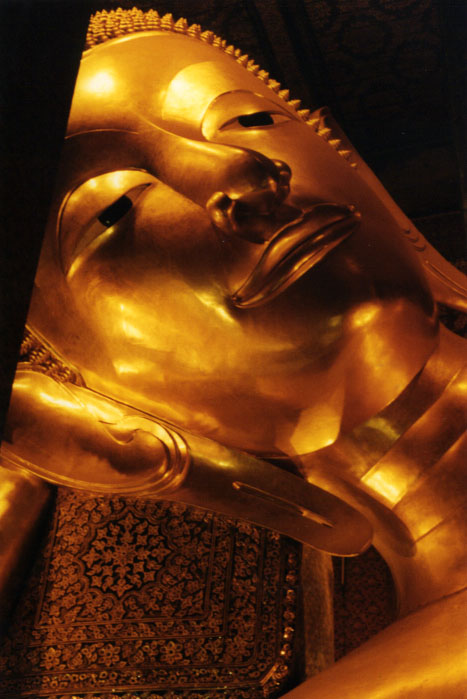
 the backfiring of buses. People hang out bus windows, trying to inhale the outside air, which is thinner than the air inside. Pedestrians play Frogger with the traffic, dodging cars, taking a step, then dodging again.
the backfiring of buses. People hang out bus windows, trying to inhale the outside air, which is thinner than the air inside. Pedestrians play Frogger with the traffic, dodging cars, taking a step, then dodging again. 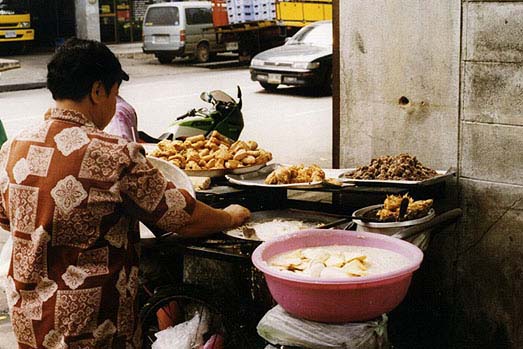
 in Bangkok. Before the skyscrapers and Kentucky Fried Chicken outlets, this magnificent temple was surrounded by a quiet fishing village. Inside its thick walls, you'd think it still is. Pillars, stupa
in Bangkok. Before the skyscrapers and Kentucky Fried Chicken outlets, this magnificent temple was surrounded by a quiet fishing village. Inside its thick walls, you'd think it still is. Pillars, stupa -shaped chedis,
-shaped chedis, gem-colored tiles and winged roofs create a spectacular landscape. Andy and I wandered the grounds. A pair of cats leapt from the temple stairs to a pile of rocks. Dogs darted around the pillars with their tails in the air. A monk cloaked in saffron robes walked by, side stepping a kitten that was happily prancing around with a dead bird in its mouth. Women opened their shop windows and dragged out their metal postcard trees. Slowly the wat came to life.
gem-colored tiles and winged roofs create a spectacular landscape. Andy and I wandered the grounds. A pair of cats leapt from the temple stairs to a pile of rocks. Dogs darted around the pillars with their tails in the air. A monk cloaked in saffron robes walked by, side stepping a kitten that was happily prancing around with a dead bird in its mouth. Women opened their shop windows and dragged out their metal postcard trees. Slowly the wat came to life. 